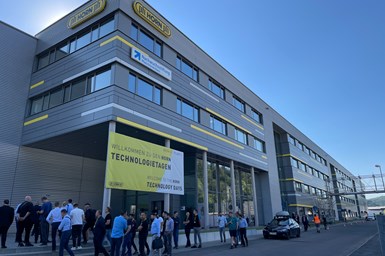
Paul Horn’s 2023 Technology Days event included 35 co-exhibiting companies as well as tours of the company’s manufacturing campus and introductions to new cutting tool technology. (All photo credits: PM)
Earlier this year, I traveled to Germany to attend Paul Horn’s Technology Days event at its headquarters in Tubingen, which was attended by more than 3,000 people. The first day, I largely took in presentations on topics such as new High-Power Impulse Magnetron Sputtering technology (developed in conjunction with CemeCon AG) for smooth finishing/eliminating droplets on physical vapor deposition (PVD) tool coatings; challenges/solutions for machining lead-free brass and steel; research into applying new mix of high-speed whirling/polygon turning/rotational turning for medical bone screws developed in conjunction with Index; the new Horn Tooling Configurator (HTC) custom tool design process; and more.
The event included 35 co-exhibiting companies, as well as tours of Paul Horn’s manufacturing campus. Check out the photos and video below to see some of what I saw.
ZykloMed is a joint project funded by Germany’s Federal Ministry of Education and Research (BMBF) including participating partners Index, Paul Horn, Beutter Präzisions-Komponenten GmbH and the wbk Institute for Production Engineering at the Karlsruhe Institute of Technology (KIT). The goal was to develop new manufacturing processes for the economical machining of medical implants with multifunctional and non-round bionic designs. The three manufacturing processes developed were eccentric turning, polygon turning and turn whirl milling. (Shown is Matthias Rommel, PH Horn co-CEO along with Markus Horn, as he described this project during the open house at Paul Horn’s Germany headquarters.)
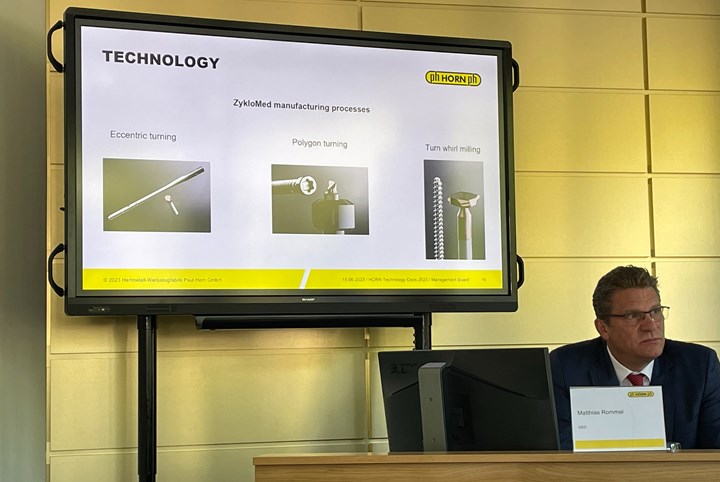
Eccentric turning uses a rotating, non-circular tool guided along a rotating workpiece under positional coupling. The speeds are brought into a certain ratio to each other and the out-of-round shape is thus reproduced. The process is said to offer highly productive production of eccentric outer contours, and the rotation of the tool reduces the thermal load at the cutting edge to extend tool life. The process also enables the production of tapered profiles.
Polygon turning is a process for producing non-circular external and internal contours with a hypotrochoid shape. Like rotary eccentric turning, the process offers the possibility of producing non-circular contours on lathes. During the process, the parallel axes of the workpiece and the tool are offset from each other by an axial distance and are brought into a specific speed ratio under positional coupling. The axial distance — the speed ratio of the workpiece to the tool and the cutting diameter of the inserts — define the dimension of the contour. A tool system for polygon turning is individually adapted to the contour of the workpiece to be produced.
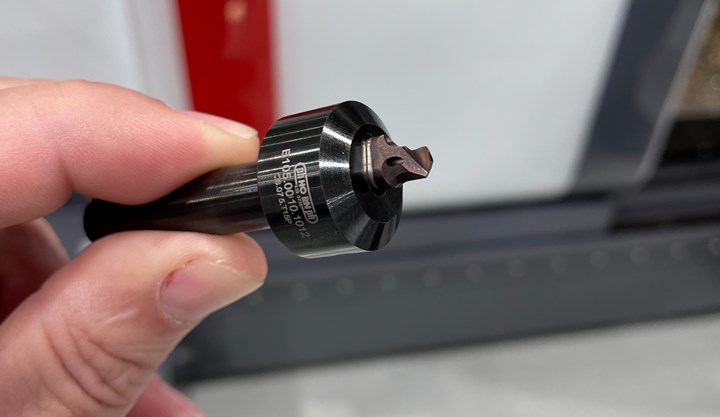
Turn whirl milling is a productive process for producing threads for bone screws. One or two circular milling cutters are set at a certain angle to the workpiece. The directions of rotation of the cutters and the workpiece can be the same or opposite. The speed ratio of the workpiece to the two cutters depends on the number of screw threads and the number of cutter inserts. The process can be used to economically produce threads with a true variable pitch by dynamically changing the thread profile.
In 2015, German tool coating company CemeCon delivered the first of three high power impulse magnetron sputtering (HiPIMS) systems to PH Horn in Germany. (The Horn USA facility in Franklin, Tennessee, now has two systems.) HiPIMS technology has several advantages and provides new opportunities when it comes to coating precision tools. It enables the formation of coatings that are very dense and compact as well as extremely hard and tough. The coatings have a very homogeneous structure and exhibit an even coating thickness even with complex tool geometries.
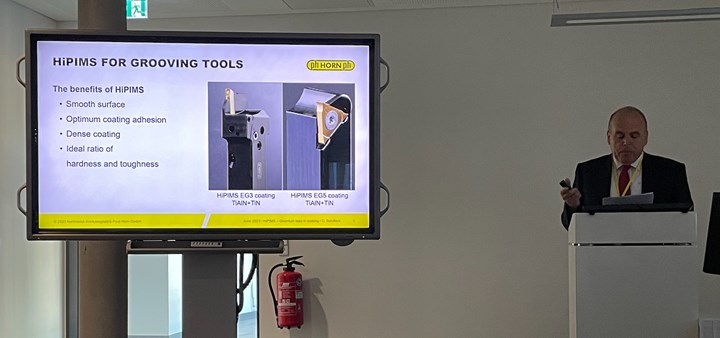
Horn’s HTC tool configurator system is designed to supply gear milling cutters in a short lead time. The HTC system offers the possibility of automatically generating a tool drawing for all gear profiles up to module 3, shortening the design phase. The system reportedly enables quotations to be generated within one working day, with technical drawings available the next working day. With the Greenline process, Horn offers delivery within five working days. The number of pieces is limited to a batch size of 50 and approval of the drawing by the customer is a prerequisite.

Here is how it all started for the Paul Horn in 1969.
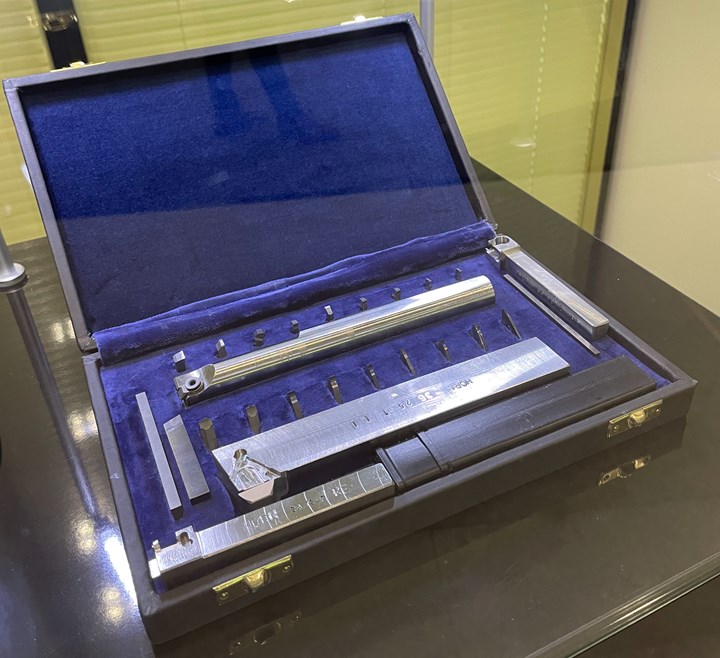
Thanks to the Horn USA team for hosting me and Gardner Business Media Vice President-Metalworking Media Bryce Ellis, on this informative and enjoyable trip.
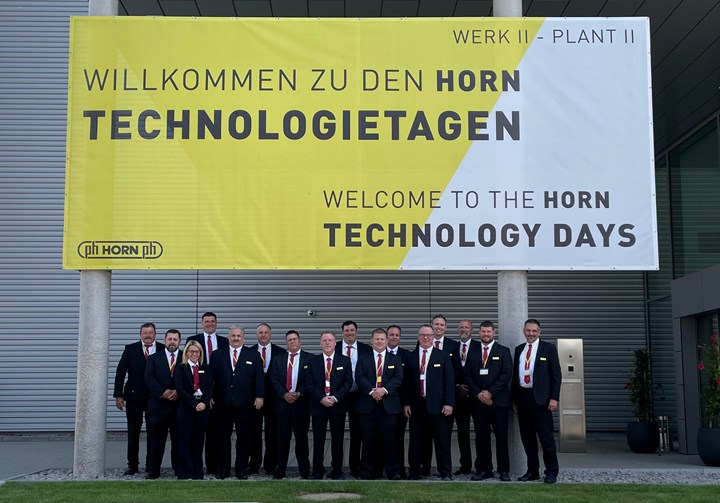
But finally, have you ever seen carbide in its malleable, green form? This video was taken at Paul Horn’s carbide production facility:
Related Content
Micromachining Fundamentals
A number of elements must come together to establish an effective process for machining at a micro level. Here we consider four.
Read MoreData Matrix Codes Offer Cutting Tool Traceability
A company’s quest to discover errors in a manufacturing process has led to printing data matrix codes on its cutting tools that provide a wealth of information for both the user and this cutting tool manufacturer.
Read MoreMaking Micro Threads
Production of micro threads can be challenging, but using the most suitable tools for a given application can simplify the task.
Read MoreProducing Micro Screws for the Watch Industry
Cutting tools play a key role in machining tiny screws on Swiss-type lathes for this Switzerland-based watch manufacturer.
Read MoreRead Next
Do You Have Single Points of Failure?
Plans need to be in place before a catastrophic event occurs.
Read MoreEmerging Leaders Nominations Now Open
Here’s your chance to highlight a young person in your manufacturing business who is on the path to be a future leader moving your company forward.
Read More5 Aspects of PMTS I Appreciate
The three-day edition of the 2025 Precision Machining Technology Show kicks off at the start of April. I’ll be there, and here are some reasons why.
Read More








.png;maxWidth=300;quality=90)














